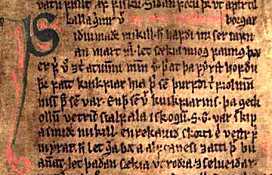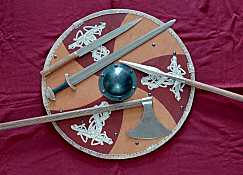
|

|
A Concordance of Arms and Combat
in the Sagas of Icelanders
The Íslendingasögur (Sagas of Icelanders, sometimes called the Icelandic family sagas) are are perhaps our most important source of information about how Vikings fought and used their weapons. In order to facilitate the use of the sagas in the study of Viking age arms and combat, I've created a file containing a list of references to arms and combat in the sagas. This page describes how the list was created and of what it is comprised.
The file lists virtually all the references to arms, armor, and combat in the sagas. For each reference, a short excerpt is provided both in Icelandic, and in English translation. Download the file using this link:
|
1.6MB pdf file |
|
The Historical Sources. The Sagas of Icelanders relate the stories of the people and families living in Iceland during the settlement and the following centuries. For a variety of reasons, the stories can not be relied on as historical fact. Nevertheless, they are an unique resource, providing a window onto the culture and society of early Iceland. |
A portion of a leaf from Hauksbók, a medieval Icelandic manuscript. This excerpt is from chapter 5 of Eiríks saga rauđa, in which Leifur Eiríksson is blown off course on his way to Greenland and ends up in Vínland |
Sources for this Project. The sources used in creating this file include:
Icelandic edition: Íslendinga sögur: Orđstöđulykill og texti. Mál og menning, 1998.
English translation: Viðar Hreinsson, ed.: The Complete Sagas of Icelanders. Leifur Eiríksson Publishing, 1997.
Other sources: Cleasby, Vigfusson, and Craigie: An Icelandic Dictionary. Oxford University Press, 1957.
In addition, various editions from the Íslenzk Fornrit series published by Hiđ íslenska bókmenntafélag were consulted.
 |
The Method Used to Create This File. I began by selecting key words relating to arms, armor, and combat (e.g., skjöldur and sverđ) that are used in the sagas. The Icelandic edition on CD-ROM allows searches on words, finding every instance of the word in the sagas. For each instance of each key word in my list, the search reported saga title, page number, and a short excerpt from the original Icelandic, showing how the word is used in context in the original. To those search results, I've added an excerpt from the English translation, along with page and volume number, as well as other information about the saga. |
 |
Some key words were discarded from the list (e.g.,víg) because they resulted in too many false positives. In instances where key words have multiple meanings (e.g., skot, meaning both a missile, and a narrow passage in a house), only those instances referring to arms or combat were retained.
Many additional passages were added manually. In most cases, the passages weren't flagged in the key word search because the weapon and its use was either implied, or was stated using more general words excluded from the key word search.
While I can't be certain that I have captured every passage of interest in the sagas, I believe this approach captures the vast majority. Some interesting passages may not have been captured in the list because the Icelandic edition does not index words in certain contexts, such as words in verses, words in proper names, and a few words apparently left out of the index inadvertently.
The data are presented in the form of a pdf version of a spreadsheet file, which can be displayed and searched using Adobe® Reader® (available as a no-cost download).
File Details. Row 1 is a header row, while row 2 lists the sources and contains a link to this page. Each remaining row lists one instance where a key word appears in a saga. The rows are ordered first by saga title, then in order of appearance in the saga. The columns are:
|
A |
English word |
The English translation of the key word. |
|
B |
Icelandic word |
The Icelandic key word used in the search. Note that the edition is in modern Icelandic, so the spelling of words may differ from that in old Icelandic dictionaries or editions such as the ÍF editions. |
|
C |
saga |
An abbreviation of the saga title. |
|
D |
page |
The page on which the word appears in the Icelandic edition. |
|
E |
page order |
The order in which each entry appears on a particular page. |
|
F |
chapter |
The chapter of the saga in which this instance occurs. |
|
G |
Icelandic word in context |
An excerpt from the original, showing this instance of the key word used in context. |
|
H |
plot |
A brief description of the plot where the key word is being used. |
|
I |
notes |
My notes on aspects of the stories where the key word appears. The notes are somewhat telegraphic, meant as a flag to remind me of items requiring further research. I've left them in this file hoping that they may be useful to other students of the saga literature. |
|
J |
English text |
The translation of the passage in which the word appears. In cases where the particular key word instance wasn't very germane, I've used ellipses to indicate that portions of sentences have been dropped. But in most cases, I've tried to be very generous in providing enough text on both sides of the key word to give a full picture of the action taking place. Many of the key words appear in close proximity. In such cases, I've provided the English translation for each instance of each word. To keep the screen size of the file reasonable, the second and subsequent appearances of the same translation are truncated to one line. |
|
K |
saga title |
The full title of the saga. |
|
L |
translation volume |
The volume in the translation in which this instance of the word appears. |
|
M |
translation page |
The page in the translation in which this instance of the word appears. |
|
N |
translation chapter |
The chapter in the translation in which this instance of the word appears. In a few instances, the chapter breaks in the translation differ from those in the edition, and as a result, chapter numbers in the Icelandic edition and the English translation may differ. |
| O | attack intent | The attacker's intent. |
| P | attack type | The type of attack used. |
| Q | attack weapon | The weapon used in the attack. |
| R | attack target | The target of the attack. |
| S | attack injury | The injury resulting from the attack. |
| T | defense | The weapon or tool used by the defender in attempting to block the attack. |
| U | fight type | A description of the type of fight in which this attack took place. |
| V | battle ID | A unique identifier for each battle described, which may be a single attack or many. |
| W | battle length | A description of how long each battle took place. |
|
X |
saga action date |
The years in which the events in the saga took place. These dates are taken from The Complete Sagas of Icelanders, where available. |
|
Y |
saga written date |
An estimate of when the saga was first written down, provided to help interpret anachronisms in the saga text. Many of these dates are speculative and debatable. These dates are taken from The Complete Sagas of Icelanders, where available. |
|
Z |
saga group |
An alternate approach to dating the sagas has been described by Vésteinn Ólason. He groups the sagas based on their features into three overlapping groups: early (1200-1280); classical (1240-1310); and late (1300-1450). For its intended purpose, I find this approach more useful than the usual contentious methods for dating the sagas. A recent summary in English of the groups appears here: Vésteinn Ólason. "Family Sagas" in A Companion to Old Norse-Icelandic Literature and Culture, edited by Rory McTurk, 114-116. Oxford: Blackwell Publishing Ltd, 2005. |
At the end of the file is a short discussion of key words which have alternate translations in other sources, and key words which, surprisingly, do not appear in the Sagas of Icelanders (e.g., geirr).
Some of the Icelandic texts are not translated because they represent alternative versions of sagas whose translation is included.
Other related resources on the Hurstwic site.
An series of articles on Viking age arms and armor.
A statistical summary of weapons and their use, as described in Sagas of Icelanders, including information on typical targets, attacks, and injuries.
An introductory article on the Sagas of Icelanders and their use as a resource in the study of Norse culture and society.
An index of other articles on the Hurstwic site.
Comments. I offer apologies for errors and omissions, and I welcome comments and corrections here.
|
|
|
|
|
|
©2004-2025 William R. Short |